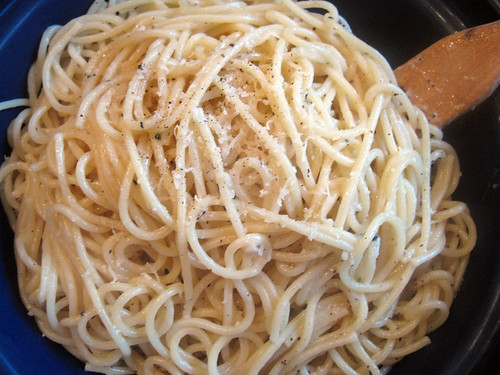
This is a famous Roman pasta dish, and I love me some Roman peasant food, so you know that it was only a matter of time before I tried my hand at cacio e pepe. As you might be able to guess, cacio e pepe relies pretty heavily on two ingredients: cheese, and pepper.
I first heard about cacio e pepe about a year and a half ago, when Saveur published an issue about Classic Roman Food. That issue has some pretty amazing recipes in it: their take on carbonara, fagioli e tonno, broccoli strascinati, milk baked fennel, pork chops agrodolce, peperonata, and finally, sweet and sour cipollini onions, which I fully intend to post about soon.
When I first read the issue this pasta dish went right down on my "to make" list, but it probably won't surprise you to learn that said list is about a mile long. Cacio e pepe might have been forgotten entirely were it not for the book and movie Eat, Pray, Love. It's admittedly a little cheesy, a little over the top, female empowerment-esque, but there were definitely moments in both the novel and film that resonated with me. I would say it's probably worth reading if you are interested in spirituality and personal growth. Otherwise it might not be your thing.
Anyway, the first section of the book takes place in Italy, where the super skinny, depressed divorcee author learns to love herself by eating carbs, namely cacio e pepe. This spaghetti dish features prominently in one scene from the movie, and Saveur was kind enough to re-post the recipe from their Roman issueon their website. At the same time, Bon Appetit posted a similar recipe that also caught my fancy. I knew it was finally time to try my hand at another Roman classic.
One thing that all Roman foods seem to have in common is that they are hell of easy to prepare, and this was no exception. I actually felt that it was a little similar to carbonara, in that both traditionally create their creamy sauces without any actual cream. Cacio e pepe is actually an even more stripped down version of carbona however, replacing the hearty bacon and egg simply with pasta water and even more cheese.
The two recipes are nearly identical. One suggests a mix of pecorino romano and grana padano or parmesan, and the other wants you to mix the romano with something called cacio de roma. One has you toast your ground pepper in butter, the other in olive oil. Otherwise, the methodology is identical: toast your pepper, add pasta water, bring it to a boil, and then add your pasta and copious amounts of grated cheese. Stir it over a fairly low flame until it all melds together into one uber creamy sauce.
This pasta is not for the faint of heart: it's A LOT of cheese, and Italian cheeses can be a little overwhelming in bulk. That being said, the sauce comes together beautifully, with an impressive ease. This is definitely a great pasta sauce to have under your belt.

No comments:
Post a Comment